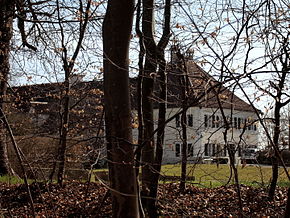Greifenberg Castle (Landsberg)
Greifenberg Castle is a castle in the municipality of Greifenberg in the Landsberg am Lech district in Upper Bavaria . It has been inhabited by the Barons of Perfall since 1478 and is not open to the public.
history

It is assumed that the former fortress Greifenberg, which lies near the Ammersee , was founded by the Counts of Andechs , who owned goods from the Amper to the Paar in the first half of the 10th century . After the death of the last Count of Andechs in 1248, the castle came into the hereditary possession of one of its ministerial families, in whom the baptismal name Grypho (= Gripho, Griffo, Greiff). was particularly common. The name Greif was called the family name and the hereditary Greifenberg Castle . The members of the family called themselves the 'Greifen von Greifenberg'.
Gripho de Andechs is regarded as the buyer and founder of Greifenberg, who is named in a foundation letter from 1230 to Scheyern as a servant and feudal man of Duke Otto II of Meran ; In 1257 it is mentioned in a document as Gripho de Greifenberg.
In 1396 Hans the Griffin took part in the crusade of King Sigismund's Nicopolis against the Turks who had invaded Hungary . The Battle of Nicopolis in the Wallachian Danube Plain ended in a heavy defeat for the Crusaders. Sultan Bajesid, the victor, had thousands of them executed, including Hans the Greif, the last castle owner of that name. In Eberhard, who is called abbot of Wessobrunn monastery from 1414-1416 , Leuthner saw a Greiff von Greiffenberg, while a current list of abbots and provosts of Wessobrunn monastery shows Eberhard Stopfer as abbot for the same period .
Then the fortress Greifenberg came to the Schweiker von Gundelfingen, who shared their inheritance in 1404. Georg von Gundelfingen now sat on Greifenberg, but in 1410 he sold the fortress back to the family of the Duke of Bavaria. In 1468 Duke Albrecht IV left Duke Wolfgang Greifenberg to his brother in exchange for his resignation from the government. In 1477, the castles Greifenberg, Hegnenberg and Planegg were assigned to Wolfgang . Duke Wolfgang, who took up residence in Lichtenberg , appointed Erhard von Perfall as Burgvogt von Greifenberg and in 1478 left the castle and maintenance to him together with all the Hofmark estates for 4,000 guilders . When Wolfgang joined the rebellion of the Löwlerbund against his brother Albrecht, he stormed Greifenberg and Hegnenberg in 1492. On the occasion of the division of Bavaria-Landshut , the castles Greifenberg, Lichtenberg and Hegnenberg were confirmed to Wolfgang in 1506.
The Hofmark Greifenburg was finally sold to their court master Erhard von Perfall by the ducal brothers in 1507 as a so-called “free, single property” . Until the 19th century, a Perfall was always Mr. von Greifenberg, to whom the patrimonial court of the Hofmark was also subordinate. In 1849 the patrimonial court, to which the localities Beuern , Eching , Pflaumdorf , Oberschondorf and partly also Unterschondorf were assigned, was dissolved.
On February 2, 1760, the southern part of the main building with the chapel burned down. The castle will then be rebuilt under the direction of Leonhard Mathias Gießl and today's four-wing castle complex with the uniform hipped roof will be created .
In October 1805, Emperor Napoleon I spent the night at Greifenberg Castle during the third coalition war .
literature
- Maximilian von Perfall : Documentary notifications about Greifenberg Castle and its owners . Munich 1846 ( full text ).
- Maximilian von Perfall : Historical description of several localities in the area around Greifenberg . Munich 1848 ( full text ).
Web links
- Municipality of Greifenberg, abridged, adapted version ( Memento from May 9, 2008 in the Internet Archive )
Individual evidence
- ↑ a b Michael Wening : Description of the Elector and Duchy of Upper and Nidern Bavaria . Part I, Munich 1701, p. 136.
- ↑ a b Wiguleus Hund : Bayrisch Stammbuch: Der first Theil, Von den Abgestorbnen Fürsten ... etc. Ingolstadt 1598, pp. 213–215.
- ↑ a b Maximilian von Perfall : Documentary communications about Greifenberg Castle and its owners . Munich 1846, p. 18.
- ↑ Coelestin Leuthner : Historia Monasterii Wessofontani , Augsburg 1755, p. 331.
- ^ Franz von Krenner : Baierische Landtag actions in the years 1429-1513 . Volume 15, Munich 1805, p. 326.
Coordinates: 48 ° 4 '12.4 " N , 11 ° 5' 9.1" E



